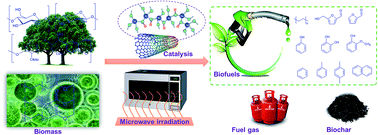An overview of a novel concept in biomass pyrolysis: microwave irradiation
Abstract
The increasing demand for renewable fuels and chemicals necessitates the exploration of alternative sources to replace petroleum sources. Biomass has been viewed as the most promising source to produce sustainable fuels and chemicals. Underpinning the key advantages of microwave heating (e.g., rapid and controlled heating, energy saving, and no requirement for agitation or fluidization), microwave-assisted pyrolysis (MAP) is one of the most attractive techniques for the valorization of biomass, which are more amenable to produce three high quality products: bio-oil, gas, and bio-char. In this respect, this article reviews the biomass pyrolysis using microwave irradiation from several points of view, starting from fundamentals of microwave irradiation, types of microwave absorbers, and chemistry of non-catalytic MAP and focusing on chemistry of catalytic MAP plus various categories of catalysts. Recent progress in the experimental studies on both non-catalytic MAP and catalytic MAP of biomass is also demonstrated with emphasis on the bio-oil yield and quality. Additionally, reaction kinetics and future prospects in the light of current studies are also given in this review. Consequently, this review illustrates both the highlights of significant achievements from biomass pyrolysis using microwave irradiation and the milestones that are necessary to be obtained in the future.



 Please wait while we load your content...
Please wait while we load your content...